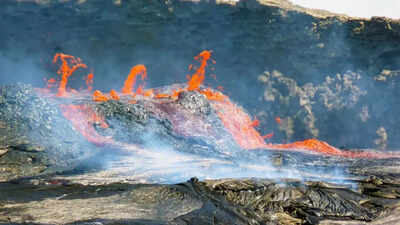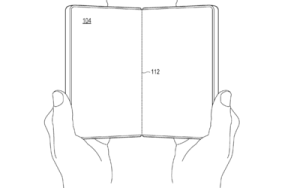In the Afar Depression of East Africa, a geological hotspot where three tectonic plates converge, groundbreaking research indicates that magma from the Earth's mantle is driving the continent's gradual splitting. Scientists have discovered that mantle upwellings in the area are not uniform, but rather consist of complex waves of molten material. This activity fuels volcanic eruptions and seismic events, weakening the Earth's crust. Ultimately, this process is expected to lead to the formation of a new ocean, separating the Horn of Africa from the rest of the continent and dramatically altering the region's geography.
 *Image: A volcano erupts in the Afar region.*
*Image: A volcano erupts in the Afar region.*
Researchers from the University of Southampton and Swansea University analyzed lava samples from over 130 young volcanoes across the Afar region. Their analysis revealed that the mantle beneath East Africa exhibits a pulsating behavior, with surges of partially molten rock rising to the surface. Each pulse possesses a unique chemical signature, suggesting that the mantle is composed of diverse materials. The thickness and movement of the overlying tectonic plates significantly influence this dynamic process.
In areas with rapid movement, such as the Red Sea Rift, mantle flow is more concentrated. In regions with slower rifting, it spreads more gradually. These pulses ascend through thinned areas of the Earth's crust, making them vulnerable to volcanic eruptions. The chemical variations observed in the lava provide insights into the Earth's internal processes, demonstrating how surface volcanic activity is linked to hidden processes occurring deep beneath the surface.
The upwelling plume is also eroding the lithosphere, reducing it to a mere 15 kilometers thick in certain parts of the Afar Depression. As the plates continue to stretch and thin, they create pathways for increased lava flow, triggering recurring volcanic eruptions and seismic events. This mirrors the geological events that shaped the Atlantic Ocean millions of years ago.
The geological activity in the Afar region is part of continental rifting, where the African, Arabian, and Somali tectonic plates are diverging. The resulting space is being filled with rising magma and newly formed crust. Over time, this rifting is expected to allow seawater to flood the region, creating a new ocean basin similar to the Atlantic.
The ongoing volcanic eruptions are already reshaping the landscape. Lava flows from the Erta Ale volcano cover extensive areas of Ethiopia, and frequent earthquake swarms indicate zones of intense tectonic stress. The Boset Volcano displays numerous layers of volcanic deposits, showcasing the long-term impact of mantle upwelling.
These discoveries provide a real-time view into the birth of an ocean and offer insights into Earth's climate and history. Similar mantle plumes in the past have generated massive volcanic provinces, such as the North Atlantic Igneous Province, which contributed to significant climate changes and potentially mass extinctions due to the release of CO₂ and sulfur dioxide.
Scientists highlight the importance of collaborative research across institutions and disciplines to fully understand these complex dynamics. Future research will focus on mapping mantle flows beneath other thinning tectonic plates and predicting how these deep forces influence surface geology. The Afar region serves as a natural laboratory for observing the relationship between Earth's interior and its evolving surface.
Newer articles
Older articles
 Vitamin D Could Slash Tooth Decay Risk by 50%, Study Suggests
Vitamin D Could Slash Tooth Decay Risk by 50%, Study Suggests
 Indian Cricket Star Mukesh Kumar and Wife Divya Singh Announce Birth of Son
Indian Cricket Star Mukesh Kumar and Wife Divya Singh Announce Birth of Son
 Shubman Gill's Captaincy Under Fire: Bold Calls Needed After England Test Defeat
Shubman Gill's Captaincy Under Fire: Bold Calls Needed After England Test Defeat
 Microsoft Aims for Foldable Redemption with Novel Hinge Design to Rival iPhone and Android
Microsoft Aims for Foldable Redemption with Novel Hinge Design to Rival iPhone and Android
 Popular Finance YouTuber's Account Hacked, Bitcoin Scam Promoted: Security Lessons Learned
Popular Finance YouTuber's Account Hacked, Bitcoin Scam Promoted: Security Lessons Learned
 Hollywood's Love Affair with India: Iconic Film Locations Revealed
Hollywood's Love Affair with India: Iconic Film Locations Revealed
 Esha Gupta Breaks Silence on Hardik Pandya Romance Rumors: 'We Were Just Talking'
Esha Gupta Breaks Silence on Hardik Pandya Romance Rumors: 'We Were Just Talking'
 Rishabh Pant Aims to Surpass Virat Kohli in Test Century Tally During England Series
Rishabh Pant Aims to Surpass Virat Kohli in Test Century Tally During England Series
 Prithvi Shaw Credits Sachin Tendulkar's Guidance for Career Revival After Setbacks
Prithvi Shaw Credits Sachin Tendulkar's Guidance for Career Revival After Setbacks
 Ashada Gupt Navratri 2025: Unveiling Dates, Timings, Significance & Secret Rituals
Ashada Gupt Navratri 2025: Unveiling Dates, Timings, Significance & Secret Rituals